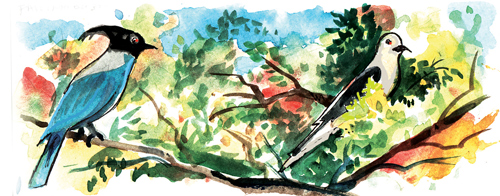New brochure catalogs Spring Mountains’ birds
The Red Rock Audubon Society's new color brochure "Bird Watching in the Spring Mountains" details a wide variety of habitats frequented by the 230 species of birds sighted in the region. Southern Nevada birders and hikers will find the slender brochure a handy year-round field guide in and around the Spring Mountains National Recreation Area.
Pick up a free copy of the brochure at the Mount Charleston visitors center along state Route 157 in Kyle Canyon, about a mile up the canyon from the Deer Creek Highway turnoff. The Mount Charleston Library also stocks copies of the new guide.
Because the guide targets bird habitats in the Red Rock Canyon National Recreation Area and nearby Spring Mountain Ranch State Park, it should soon be available at visitor centers in these sites, too.
Copies of the brochure are also available at monthly meetings of the Red Rock Audubon Society, which occur at 7 p.m. on the second Monday of each month in the Wengert Room of the NV Energy building at 6226 W. Sahara Ave. The next local chapter meeting on Nov. 14 will feature information on developing backyard habitats.
Several members of the Red Rock Audubon Society with expert birding skills and extensive knowledge of the area worked on "Bird Watching in the Spring Mountains" with the Nevada Division of State Lands, the U.S. Forest Service, mountain residents and other agencies. All of the color photos of birds in the guide were taken by local Audubon Society members.
The brochure and associated postcards were produced through a grant from the Mount Charleston License Plate Program.
The brochure includes simple maps of roads and trails in the Humboldt-Toiyabe National Forest and an inset map of the greater Spring Mountains complex of recreation areas. For detailed trail maps and information on facilities, check with the administrating agency such as the U.S. Forest Service, the Bureau of Land Management or the Nevada Division of State Parks.
The Audubon Society guide provides helpful information on guidelines and bird-watching tips. It details 10 habitats in the area from Mojave shrub land at around 4,000 feet of elevation through several forest regions to alpine locations above 11,000 feet, as well as areas with open ponds, riparian areas, rocky cliffs and locations modified by housing or agricultural activities.
Several pages list the 230 species of birds seen in the mountainous country west of Las Vegas, well over half of the 406 species known to inhabit or visit Clark County. The guide tells users which time of the year birds might be seen, their abundance and locations where they have been sighted. More than 60 species live in the area year-round. Many are found there only seasonally, staying over to spend the summer or winter. Others are just passing through during spring and fall migrations.
The Spring Mountains birding brochure is intended for use in the field with more complete bird books such as Peterson's "Field Guide to Western Birds" or the national Audubon Society's "Field Guide to North American Birds." These guides provide detailed color illustrations or photos, as well as information about nesting, calls, behavior and differences in sexes and degree of maturity.
Outings with experts also enhance birding experiences. Get to know some local birders on outings such as those scheduled for 8 a.m. on the first Saturday of the month at the Springs Preserve or at 8 a.m. on the third Saturday of the month at Floyd Lamb Park at Tule Springs.
Margo Bartlett Pesek's column appears Sundays.






















